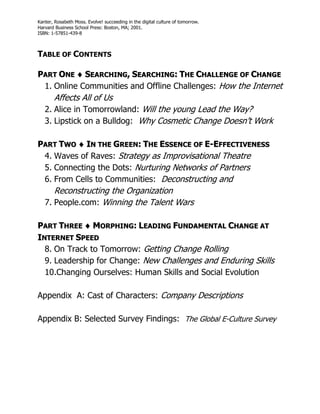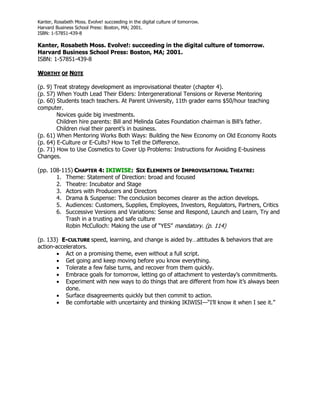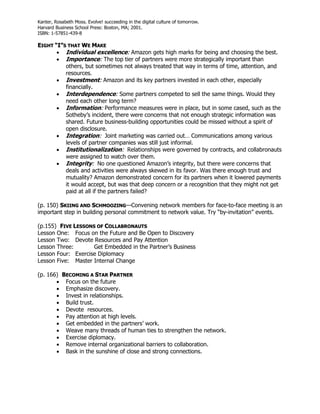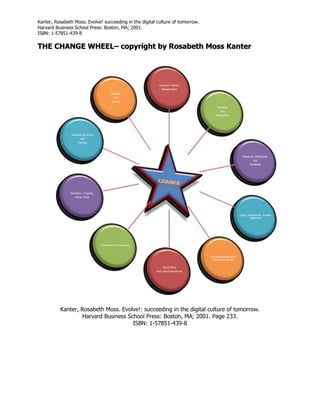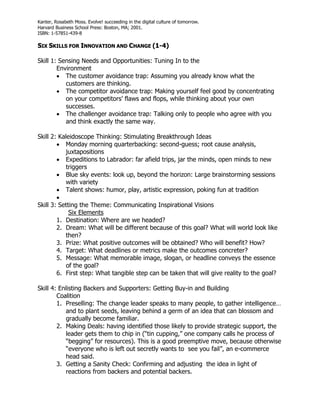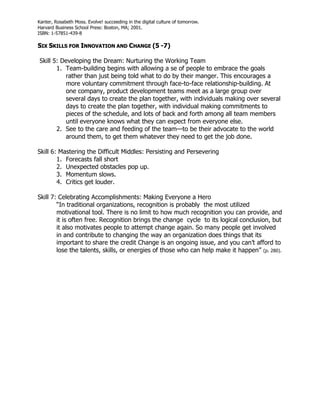Evolve The Song By Rosabeth Moss Kanter
- 1. Evolve! – The SongLyrics by Rosabeth Moss Kanter[chorus]Get ready for the next step,Select the best step.It’s a leap in evolutionFrom the Internet revolution.Just pick a directionIn this world of connection.So many problems to solve–You’ve got to evolve.IWhen outcomes are uncertain, answers hard to devise,That’s time to form a team, tap dreams, and improvise.Listen to your audience; build a scene on every hope,Shake up thinking; see new patterns in the kaleidoscope.You don’t have to play alone, so start placing your betOn links to lots of partners, near and far across the net.Join hands beyond tall silos, step out of the lonely cells,See a common state, collaborate, for community wealth.[chorus]IIPutting lipstick on a bulldog won’t transform enough,Makeup can’t hide everything: change takes deeper stuff.Shift the mood, adjust your attitude, before you go online;Find new habits of mind, don’t just dwell on what’s behind.Don’t be trapped by old divisions, on a patch of tiny turf,That means settling for less—there’s more you could be worth.Think big! Think bold! Think of new things to create.First-rate prizes go to leaders who can innovate.[chorus]IIIWhy are you so silent, has the mouse got your tongue?Tech talk is what the older folks can learn from the young.But the Net generation must absorb from the past,Enduring values of service, how to build things that last.So rally people power, make the world a better place,Because we live on the ground, not in cyberspace.The computer can help us but it’s only just a tool;It’s humanity’s goals that should make all the rules.[chorus]Get ready for the next step,Select the best step.It’s a leap in evolutionFrom the Internet revolution.Just pick a directionIn this world of connection.So many problems to solve–You’ve got to evolve.Table of ContentsPart One Searching, Searching: The Challenge of ChangeOnline Communities and Offline Challenges: How the Internet Affects All of UsAlice in Tomorrowland: Will the young Lead the Way?Lipstick on a Bulldog: Why Cosmetic Change Doesn’t WorkPart Two In the Green: The Essence of E-EffectivenessWaves of Raves: Strategy as Improvisational TheatreConnecting the Dots: Nurturing Networks of PartnersFrom Cells to Communities: Deconstructing and Reconstructing the OrganizationPeople.com: Winning the Talent WarsPart Three Morphing: Leading Fundamental Change at Internet SpeedOn Track to Tomorrow: Getting Change RollingLeadership for Change: New Challenges and Enduring SkillsChanging Ourselves: Human Skills and Social EvolutionAppendix A: Cast of Characters: Company DescriptionsAppendix B: Selected Survey Findings: The Global E-Culture SurveyKanter, Rosabeth Moss. Evolve!: succeeding in the digital culture of tomorrow.Harvard Business School Press: Boston, MA; 2001.ISBN: 1-57851-439-8Worthy of Note(p. 9) Treat strategy development as improvisational theater (chapter 4).(p. 57) When Youth Lead Their Elders: Intergenerational Tensions or Reverse Mentoring(p. 60) Students teach teachers. At Parent University, 11th grader earns $50/hour teaching computer.Novices guide big investments.Children hire parents: Bill and Melinda Gates Foundation chairman is Bill’s father.Children rival their parent’s in business.(p. 61) When Mentoring Works Both Ways: Building the New Economy on Old Economy Roots(p. 64) E-Culture or E-Cults? How to Tell the Difference.(p. 71) How to Use Cosmetics to Cover Up Problems: Instructions for Avoiding E-business Changes.(pp. 108-115) Chapter 4: IKIWISE: Six Elements of Improvisational Theatre:Theme: Statement of Direction: broad and focusedTheatre: Incubator and StageActors with Producers and DirectorsDrama & Suspense: The conclusion becomes clearer as the action develops.Audiences: Customers, Supplies, Employees, Investors, Regulators, Partners, CriticsSuccessive Versions and Variations: Sense and Respond, Launch and Learn, Try and Trash in a trusting and safe cultureRobin McCulloch: Making the use of “YES” mandatory. (p. 114)(p. 133) E-culture speed, learning, and change is aided by…attitudes & behaviors that are action-accelerators.Act on a promising theme, even without a full script.Get going and keep moving before you know everything.Tolerate a few false turns, and recover from them quickly.Embrace goals for tomorrow, letting go of attachment to yesterday’s commitments.Experiment with new ways to do things that are different from how it’s always been done.Surface disagreements quickly but then commit to action.Be comfortable with uncertainty and thinking IKIWISI—“I’ll know it when I see it.”Eight “I”s that We MakeIndividual excellence: Amazon gets high marks for being and choosing the best.Importance: The top tier of partners were more strategically important than others, but sometimes not always treated that way in terms of time, attention, and resources.Investment: Amazon and its key partners invested in each other, especially financially.Interdependence: Some partners competed to sell the same things. Would they need each other long term?Information: Performance measures were in place, but in some cased, such as the Sotheby’s incident, there were concerns that not enough strategic information was shared. Future business-building opportunities could be missed without a spirit of open disclosure.Integration: Joint marketing was carried out… Communications among various levels of partner companies was still just informal.Institutionalization: Relationships were governed by contracts, and collabronauts were assigned to watch over them.Integrity: No one questioned Amazon’s integrity, but there were concerns that deals and activities were always skewed in its favor. Was there enough trust and mutuality? Amazon demonstrated concern for its partners when it lowered payments it would accept, but was that deep concern or a recognition that they might not get paid at all if the partners failed?(p. 150) Skiing and Schmoozing—Convening network members for face-to-face meeting is an important step in building personal commitment to network value. Try “by-invitation” events.(p.155) Five Lessons of CollabronautsLesson One:Focus on the Future and Be Open to DiscoveryLesson Two:Devote Resources and Pay AttentionLesson Three: Get Embedded in the Partner’s BusinessLesson Four: Exercise DiplomacyLesson Five:Master Internal Change(p. 166) Becoming a Star PartnerFocus on the futureEmphasize discovery.Invest in relationships.Build trust.Devote resources.Pay attention at high levels.Get embedded in the partners’ work.Weave many threads of human ties to strengthen the network.Exercise diplomacy.Remove internal organizational barriers to collaboration.Bask in the sunshine of close and strong connections.Six elements of Constructing Organizational CommunityA balanced governance structure.Shared disciplines and routines.Multichannel, multidirectional communication.Integrators. Communities are building through networks of people who meet across areas to share knowledge. Network champions hold people together. Appointing official integrators—internal ambassadors and diplomats—ties cells and silos together. They build community not just through tasks but through the folklore and war stories they convey. Just as the Web needs webmasters, e-culture communities need wandering minstrels.Cross-cutting relationships. Personal relationships are vitally important. It helps to have people with strong social skills who team oriented and collaborative: innovators … must build coalitions of supporters in order to lead significant change. Insiders with long service help build community. Communities are built around people who know each other, understand each other, like each other, and have a shared history.Shared identity, shared fate. [LOST: Live Together; Die Alone.] Collaboration is not altruism: it stems in part from people identifying with each other and feeling that they share a fate. Incentives that induce cooperation are a starting point. A shared identity is fostered, too, by role switching and job exchanges. Career paths can carry people across silos. Task teams can routinely include people from many silos. Collaboration works best when it is mutual: Each participant gets something out of it. Each feels good about his or her own part in the success of the whole. Pride in collective achievements reinforces a shared identity. Service to the external community can unite the internal community. But that’s not enough without pride in each other. Strong communities thrive on trust and mutual respect. People must respect each other’s differences without using them to divide.Chapter 7: People.com: Winning the Talent WarsPeople, People, People. Ask any future-oriented employer today what their biggest asset is, and that’s the answer. Ask those same employers what their biggest headache is, and that’s still the answer. Attracting people, motivating people, and retaining, people.What will I remember most?.... The feeling of belonging to a smart set of people spread across the globe. I’ve seen exponential growth and am continuously awed by our collective knowledge, creativity, and teamwork. (Website producer at Razorfish, now working at another company)You are on a mission from God. (Heal Yan’s paraphrase of CEO Scott McNealy’s message to her Sun Microsystems team)Stuck in a .bomb? (Recruiting ad on a San Francisco billboard).(p. 198) The Commitment Crisis(p. 204) Mastery, Membership, and Meaning: three Dimensions of CommitmentMastery: Caring about Today, Thinking about Tomorrow. Opportunity, Options, and OwnershipMembership: Cementing the We, Caring About MeWelcome to the Community.Someone to Watch Over MeHonoring Personal InterestsRecognitionMeaning: Believing in a Larger Picture(p. 221) Return of the Nomads: The Virtuous Circle of Attract and Retain“Companies attuned to e-culture have stopped shunning those who leave and have begun to consider them alumni who meet for reunions and continue to support the institution even after leaving.” (Of course, companies don’t want to make it too easy for people to leave by holding the door open for their return.)Andres Rodriguez: “The best consequence of having a good place to work is that people bring their friends.” (p. 229) You’ve got to be prepared to change the genetic code of the organization.THE CHANGE WHEEL– copyright by Rosabeth Moss Kanter274320168275Kanter, Rosabeth Moss. Evolve!: succeeding in the digital culture of tomorrow. Harvard Business School Press: Boston, MA; 2001. Page 233.ISBN: 1-57851-439-8Chapter 9: Leadership for Change New Challenges and Enduring Skills(p. 256-7) Ten Reasons People Resist Change (10 Leadership Work Arounds)Loss of face. Fear that dignity will be undermined, a place of honor removed; embarrassment because the change feels like exposure for past mistakes.Loss of control. Anger at decisions being taken out of one’s hands, power shifting elsewhere.Excess uncertainty. Feeling uninformed about where the change will lead, what is coming next—a sensation like walking off a cliff blindfolded.Surprise, surprise! Automatic defensiveness—no advance warning, no chance to get ready.The “difference” effect. Rejection of the change because it doesn’t fit existing mental models, seems strange and unfamiliar, and challenges usually unquestioned habits and routines.“Can I do it?” Concerns about future competence, worries about whether one will still be successful after the change.Ripple effects. Annoyance at disruptions to other activities and interference with the accomplishment of unrelated tasks.More work. Resistance to additional things to do, new things to learn, and no time to do it all.Past resentments. Memories of past hostilities or problems that were never resolved.Real threats. Anger that the change will inflict real pain and create clear losers.Seven Classic Skills Are Involved In Innovation and ChangeTuning in to the EnvironmentKaleidoscope Thinking, An inspiring vision, Coalition Building, Nurturing a Working Team,Persisting Through Difficulties, and Spreading Credit and Recognition(p. 300) “In every best-practice case in this back, from businesses to public schools, the real and the virtual interact. They reinforce each other. They push each other for change.Six Skills for Innovation and Change (1-4)Skill 1: Sensing Needs and Opportunities: Tuning In to the EnvironmentThe customer avoidance trap: Assuming you already know what the customers are thinking.The competitor avoidance trap: Making yourself feel good by concentrating on your competitors’ flaws and flops, while thinking about your own successes.The challenger avoidance trap: Talking only to people who agree with you and think exactly the same way.Skill 2: Kaleidoscope Thinking: Stimulating Breakthrough IdeasMonday morning quarterbacking: second-guess; root cause analysis, juxtapositionsExpeditions to Labrador: far afield trips, jar the minds, open minds to new triggersBlue sky events: look up, beyond the horizon: Large brainstorming sessions with varietyTalent shows: humor, play, artistic expression, poking fun at traditionSkill 3: Setting the Theme: Communicating Inspirational Visions Six ElementsDestination: Where are we headed?Dream: What will be different because of this goal? What will world look like then?Prize: What positive outcomes will be obtained? Who will benefit? How?Target: What deadlines or metrics make the outcomes concreter?Message: What memorable image, slogan, or headline conveys the essence of the goal?First step: What tangible step can be taken that will give reality to the goal?Skill 4: Enlisting Backers and Supporters: Getting Buy-in and Building CoalitionPreselling: The change leader speaks to many people, to gather intelligence… and to plant seeds, leaving behind a germ of an idea that can blossom and gradually become familiar.Making Deals: having identified those likely to provide strategic support, the leader gets them to chip in (“tin cupping,” one company calls he process of “begging” for resources). This is a good preemptive move, because otherwise “everyone who is left out secretly wants to see you fail”, an e-commerce head said.Getting a Sanity Check: Confirming and adjusting the idea in light of reactions from backers and potential backers.Six Skills for Innovation and Change (5 -7) Skill 5: Developing the Dream: Nurturing the Working TeamTeam-building begins with allowing a se of people to embrace the goals rather than just being told what to do by their manger. This encourages a more voluntary commitment through face-to-face relationship-building. At one company, product development teams meet as a large group over several days to create the plan together, with individuals making over several days to create the plan together, with individual making commitments to pieces of the schedule, and lots of back and forth among all team members until everyone knows what they can expect from everyone else.See to the care and feeding of the team—to be their advocate to the world around them, to get them whatever they need to get the job done. Skill 6: Mastering the Difficult Middles: Persisting and PerseveringForecasts fall shortUnexpected obstacles pop up.Momentum slows.Critics get louder.Skill 7: Celebrating Accomplishments: Making Everyone a Hero“In traditional organizations, recognition is probably the most utilized motivational tool. There is no limit to how much recognition you can provide, and it is often free. Recognition brings the change cycle to its logical conclusion, but it also motivates people to attempt change again. So many people get involved in and contribute to changing the way an organization does things that its important to share the credit Change is an ongoing issue, and you can’t afford to lose the talents, skills, or energies of those who can help make it happen” (p. 280).

![Evolve! – The SongLyrics by Rosabeth Moss Kanter[chorus]Get ready for the next step,Select the best step.It’s a leap in evolutionFrom the Internet revolution.Just pick a directionIn this world of connection.So many problems to solve–You’ve got to evolve.IWhen outcomes are uncertain, answers hard to devise,That’s time to form a team, tap dreams, and improvise.Listen to your audience; build a scene on every hope,Shake up thinking; see new patterns in the kaleidoscope.You don’t have to play alone, so start placing your betOn links to lots of partners, near and far across the net.Join hands beyond tall silos, step out of the lonely cells,See a common state, collaborate, for community wealth.[chorus]IIPutting lipstick on a bulldog won’t transform enough,Makeup can’t hide everything: change takes deeper stuff.Shift the mood, adjust your attitude, before you go online;Find new habits of mind, don’t just dwell on what’s behind.Don’t be trapped by old divisions, on a patch of tiny turf,That means settling for less—there’s more you could be worth.Think big! Think bold! Think of new things to create.First-rate prizes go to leaders who can innovate.[chorus]IIIWhy are you so silent, has the mouse got your tongue?Tech talk is what the older folks can learn from the young.But the Net generation must absorb from the past,Enduring values of service, how to build things that last.So rally people power, make the world a better place,Because we live on the ground, not in cyberspace.The computer can help us but it’s only just a tool;It’s humanity’s goals that should make all the rules.[chorus]Get ready for the next step,Select the best step.It’s a leap in evolutionFrom the Internet revolution.Just pick a directionIn this world of connection.So many problems to solve–You’ve got to evolve.Table of ContentsPart One Searching, Searching: The Challenge of ChangeOnline Communities and Offline Challenges: How the Internet Affects All of UsAlice in Tomorrowland: Will the young Lead the Way?Lipstick on a Bulldog: Why Cosmetic Change Doesn’t WorkPart Two In the Green: The Essence of E-EffectivenessWaves of Raves: Strategy as Improvisational TheatreConnecting the Dots: Nurturing Networks of PartnersFrom Cells to Communities: Deconstructing and Reconstructing the OrganizationPeople.com: Winning the Talent WarsPart Three Morphing: Leading Fundamental Change at Internet SpeedOn Track to Tomorrow: Getting Change RollingLeadership for Change: New Challenges and Enduring SkillsChanging Ourselves: Human Skills and Social EvolutionAppendix A: Cast of Characters: Company DescriptionsAppendix B: Selected Survey Findings: The Global E-Culture SurveyKanter, Rosabeth Moss. Evolve!: succeeding in the digital culture of tomorrow.Harvard Business School Press: Boston, MA; 2001.ISBN: 1-57851-439-8Worthy of Note(p. 9) Treat strategy development as improvisational theater (chapter 4).(p. 57) When Youth Lead Their Elders: Intergenerational Tensions or Reverse Mentoring(p. 60) Students teach teachers. At Parent University, 11th grader earns $50/hour teaching computer.Novices guide big investments.Children hire parents: Bill and Melinda Gates Foundation chairman is Bill’s father.Children rival their parent’s in business.(p. 61) When Mentoring Works Both Ways: Building the New Economy on Old Economy Roots(p. 64) E-Culture or E-Cults? How to Tell the Difference.(p. 71) How to Use Cosmetics to Cover Up Problems: Instructions for Avoiding E-business Changes.(pp. 108-115) Chapter 4: IKIWISE: Six Elements of Improvisational Theatre:Theme: Statement of Direction: broad and focusedTheatre: Incubator and StageActors with Producers and DirectorsDrama & Suspense: The conclusion becomes clearer as the action develops.Audiences: Customers, Supplies, Employees, Investors, Regulators, Partners, CriticsSuccessive Versions and Variations: Sense and Respond, Launch and Learn, Try and Trash in a trusting and safe cultureRobin McCulloch: Making the use of “YES” mandatory. (p. 114)(p. 133) E-culture speed, learning, and change is aided by…attitudes & behaviors that are action-accelerators.Act on a promising theme, even without a full script.Get going and keep moving before you know everything.Tolerate a few false turns, and recover from them quickly.Embrace goals for tomorrow, letting go of attachment to yesterday’s commitments.Experiment with new ways to do things that are different from how it’s always been done.Surface disagreements quickly but then commit to action.Be comfortable with uncertainty and thinking IKIWISI—“I’ll know it when I see it.”Eight “I”s that We MakeIndividual excellence: Amazon gets high marks for being and choosing the best.Importance: The top tier of partners were more strategically important than others, but sometimes not always treated that way in terms of time, attention, and resources.Investment: Amazon and its key partners invested in each other, especially financially.Interdependence: Some partners competed to sell the same things. Would they need each other long term?Information: Performance measures were in place, but in some cased, such as the Sotheby’s incident, there were concerns that not enough strategic information was shared. Future business-building opportunities could be missed without a spirit of open disclosure.Integration: Joint marketing was carried out… Communications among various levels of partner companies was still just informal.Institutionalization: Relationships were governed by contracts, and collabronauts were assigned to watch over them.Integrity: No one questioned Amazon’s integrity, but there were concerns that deals and activities were always skewed in its favor. Was there enough trust and mutuality? Amazon demonstrated concern for its partners when it lowered payments it would accept, but was that deep concern or a recognition that they might not get paid at all if the partners failed?(p. 150) Skiing and Schmoozing—Convening network members for face-to-face meeting is an important step in building personal commitment to network value. Try “by-invitation” events.(p.155) Five Lessons of CollabronautsLesson One:Focus on the Future and Be Open to DiscoveryLesson Two:Devote Resources and Pay AttentionLesson Three: Get Embedded in the Partner’s BusinessLesson Four: Exercise DiplomacyLesson Five:Master Internal Change(p. 166) Becoming a Star PartnerFocus on the futureEmphasize discovery.Invest in relationships.Build trust.Devote resources.Pay attention at high levels.Get embedded in the partners’ work.Weave many threads of human ties to strengthen the network.Exercise diplomacy.Remove internal organizational barriers to collaboration.Bask in the sunshine of close and strong connections.Six elements of Constructing Organizational CommunityA balanced governance structure.Shared disciplines and routines.Multichannel, multidirectional communication.Integrators. Communities are building through networks of people who meet across areas to share knowledge. Network champions hold people together. Appointing official integrators—internal ambassadors and diplomats—ties cells and silos together. They build community not just through tasks but through the folklore and war stories they convey. Just as the Web needs webmasters, e-culture communities need wandering minstrels.Cross-cutting relationships. Personal relationships are vitally important. It helps to have people with strong social skills who team oriented and collaborative: innovators … must build coalitions of supporters in order to lead significant change. Insiders with long service help build community. Communities are built around people who know each other, understand each other, like each other, and have a shared history.Shared identity, shared fate. [LOST: Live Together; Die Alone.] Collaboration is not altruism: it stems in part from people identifying with each other and feeling that they share a fate. Incentives that induce cooperation are a starting point. A shared identity is fostered, too, by role switching and job exchanges. Career paths can carry people across silos. Task teams can routinely include people from many silos. Collaboration works best when it is mutual: Each participant gets something out of it. Each feels good about his or her own part in the success of the whole. Pride in collective achievements reinforces a shared identity. Service to the external community can unite the internal community. But that’s not enough without pride in each other. Strong communities thrive on trust and mutual respect. People must respect each other’s differences without using them to divide.Chapter 7: People.com: Winning the Talent WarsPeople, People, People. Ask any future-oriented employer today what their biggest asset is, and that’s the answer. Ask those same employers what their biggest headache is, and that’s still the answer. Attracting people, motivating people, and retaining, people.What will I remember most?.... The feeling of belonging to a smart set of people spread across the globe. I’ve seen exponential growth and am continuously awed by our collective knowledge, creativity, and teamwork. (Website producer at Razorfish, now working at another company)You are on a mission from God. (Heal Yan’s paraphrase of CEO Scott McNealy’s message to her Sun Microsystems team)Stuck in a .bomb? (Recruiting ad on a San Francisco billboard).(p. 198) The Commitment Crisis(p. 204) Mastery, Membership, and Meaning: three Dimensions of CommitmentMastery: Caring about Today, Thinking about Tomorrow. Opportunity, Options, and OwnershipMembership: Cementing the We, Caring About MeWelcome to the Community.Someone to Watch Over MeHonoring Personal InterestsRecognitionMeaning: Believing in a Larger Picture(p. 221) Return of the Nomads: The Virtuous Circle of Attract and Retain“Companies attuned to e-culture have stopped shunning those who leave and have begun to consider them alumni who meet for reunions and continue to support the institution even after leaving.” (Of course, companies don’t want to make it too easy for people to leave by holding the door open for their return.)Andres Rodriguez: “The best consequence of having a good place to work is that people bring their friends.” (p. 229) You’ve got to be prepared to change the genetic code of the organization.THE CHANGE WHEEL– copyright by Rosabeth Moss Kanter274320168275Kanter, Rosabeth Moss. Evolve!: succeeding in the digital culture of tomorrow. Harvard Business School Press: Boston, MA; 2001. Page 233.ISBN: 1-57851-439-8Chapter 9: Leadership for Change New Challenges and Enduring Skills(p. 256-7) Ten Reasons People Resist Change (10 Leadership Work Arounds)Loss of face. Fear that dignity will be undermined, a place of honor removed; embarrassment because the change feels like exposure for past mistakes.Loss of control. Anger at decisions being taken out of one’s hands, power shifting elsewhere.Excess uncertainty. Feeling uninformed about where the change will lead, what is coming next—a sensation like walking off a cliff blindfolded.Surprise, surprise! Automatic defensiveness—no advance warning, no chance to get ready.The “difference” effect. Rejection of the change because it doesn’t fit existing mental models, seems strange and unfamiliar, and challenges usually unquestioned habits and routines.“Can I do it?” Concerns about future competence, worries about whether one will still be successful after the change.Ripple effects. Annoyance at disruptions to other activities and interference with the accomplishment of unrelated tasks.More work. Resistance to additional things to do, new things to learn, and no time to do it all.Past resentments. Memories of past hostilities or problems that were never resolved.Real threats. Anger that the change will inflict real pain and create clear losers.Seven Classic Skills Are Involved In Innovation and ChangeTuning in to the EnvironmentKaleidoscope Thinking, An inspiring vision, Coalition Building, Nurturing a Working Team,Persisting Through Difficulties, and Spreading Credit and Recognition(p. 300) “In every best-practice case in this back, from businesses to public schools, the real and the virtual interact. They reinforce each other. They push each other for change.Six Skills for Innovation and Change (1-4)Skill 1: Sensing Needs and Opportunities: Tuning In to the EnvironmentThe customer avoidance trap: Assuming you already know what the customers are thinking.The competitor avoidance trap: Making yourself feel good by concentrating on your competitors’ flaws and flops, while thinking about your own successes.The challenger avoidance trap: Talking only to people who agree with you and think exactly the same way.Skill 2: Kaleidoscope Thinking: Stimulating Breakthrough IdeasMonday morning quarterbacking: second-guess; root cause analysis, juxtapositionsExpeditions to Labrador: far afield trips, jar the minds, open minds to new triggersBlue sky events: look up, beyond the horizon: Large brainstorming sessions with varietyTalent shows: humor, play, artistic expression, poking fun at traditionSkill 3: Setting the Theme: Communicating Inspirational Visions Six ElementsDestination: Where are we headed?Dream: What will be different because of this goal? What will world look like then?Prize: What positive outcomes will be obtained? Who will benefit? How?Target: What deadlines or metrics make the outcomes concreter?Message: What memorable image, slogan, or headline conveys the essence of the goal?First step: What tangible step can be taken that will give reality to the goal?Skill 4: Enlisting Backers and Supporters: Getting Buy-in and Building CoalitionPreselling: The change leader speaks to many people, to gather intelligence… and to plant seeds, leaving behind a germ of an idea that can blossom and gradually become familiar.Making Deals: having identified those likely to provide strategic support, the leader gets them to chip in (“tin cupping,” one company calls he process of “begging” for resources). This is a good preemptive move, because otherwise “everyone who is left out secretly wants to see you fail”, an e-commerce head said.Getting a Sanity Check: Confirming and adjusting the idea in light of reactions from backers and potential backers.Six Skills for Innovation and Change (5 -7) Skill 5: Developing the Dream: Nurturing the Working TeamTeam-building begins with allowing a se of people to embrace the goals rather than just being told what to do by their manger. This encourages a more voluntary commitment through face-to-face relationship-building. At one company, product development teams meet as a large group over several days to create the plan together, with individuals making over several days to create the plan together, with individual making commitments to pieces of the schedule, and lots of back and forth among all team members until everyone knows what they can expect from everyone else.See to the care and feeding of the team—to be their advocate to the world around them, to get them whatever they need to get the job done. Skill 6: Mastering the Difficult Middles: Persisting and PerseveringForecasts fall shortUnexpected obstacles pop up.Momentum slows.Critics get louder.Skill 7: Celebrating Accomplishments: Making Everyone a Hero“In traditional organizations, recognition is probably the most utilized motivational tool. There is no limit to how much recognition you can provide, and it is often free. Recognition brings the change cycle to its logical conclusion, but it also motivates people to attempt change again. So many people get involved in and contribute to changing the way an organization does things that its important to share the credit Change is an ongoing issue, and you can’t afford to lose the talents, skills, or energies of those who can help make it happen” (p. 280).](https://image.slidesharecdn.com/evolvethesong-by-rosabeth-moss-kanter-1266599600-phpapp01/85/Evolve-The-Song-By-Rosabeth-Moss-Kanter-1-320.jpg)
